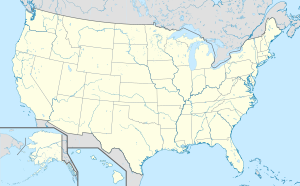Tunkhannock Viaduct
Coordinates: 41 ° 37 ′ 30 ″ N , 75 ° 46 ′ 35 ″ W.
| Tunkhannock Viaduct | ||
|---|---|---|
| use | Railway bridge | |
| Crossing of | Tunkhannock Creek | |
| place | Nicholson, Wyoming County , Pennsylvania | |
| construction | Reinforced concrete viaduct | |
| overall length | 724 m | |
| width | 10.4 m | |
| Number of openings | ten | |
| Longest span | 54.8 m | |
| start of building | 1912 | |
| completion | 1915 | |
| planner | Abraham Burton Cohen | |
| location | ||
|
|
||
The Tunkhannock Viaduct (also Tunkhannock Creek Viaduct or Nicholson Bridge ) next to the small town of Nicholson, Wyoming County , Pennsylvania , USA , is the largest of the railway viaducts that the Delaware, Lackawanna and Western Railroad in the context of the construction of Nicholson cut-off in the Between 1912 and 1915. It crosses Tunkhannock Creek, a small tributary of the Susquehanna River , as well as State Road 92.
history
The Delaware, Lackawanna and Western Railroad (DL&W) was in the course of the development of the anthracite coal deposits in the northeast Appalachians , u. a. in Lackawanna County . Their network stretched from New York City to Buffalo on Lake Erie and Oswego on Lake Ontario . In the years 1908 to 1911 she had the Lackawanna Cut-Off built, a shortcut with the straightest possible routes, slight inclines and no level crossings, which increased the speed of trains, shortened travel times and increased the company's profits. This route required long dams and cuts in the terrain as well as large viaducts such as the Paulinskill Viaduct and the Delaware River Viaduct . As part of another shortcut built between 1912 and 1915, the Nicholson Cut-Off between Scranton and Binghamton , the even larger Tunkhannock Viaduct was created. These three viaducts were among the first large reinforced concrete bridges and replaced each other as the largest reinforced concrete bridges in the world.
description
The viaduct was originally designed for double-track traffic, but is currently only used as a single-track. It was built entirely from reinforced concrete according to the plans of Abraham Burton Cohen, the chief civil engineer at DL&W . The structure is a total of 724 m (2375 ft ) long and 10.4 m (34 ft) wide. The trains run at a height of 73 m (240 ft) above the river bed. The ten openings of the viaduct have spans of 54.8 m (180 ft). They each consist of two parallel round arches , the strength of which increases towards the fighters , as their soffits are made up of semicircles with a radius of 90 ft, while the arch shoulders are made up of semicircles with a radius of 111 ft and a center 13 ft lower. The roadway girder is elevated with eight slender arches on each of the large round arches. The 8.5 m (28 ft) wide, upwardly tapering to 6.2 m (20 ft 5 inches) pillars stand on foundations that reach down to the natural rock, some of which is only 42 m (138 ft) below Surface was encountered. As a result, almost half of the concrete used was used for the foundations.
The Tunkhannock Viaduct was added to the List of National Historic Civil Engineering Landmarks by the American Society of Civil Engineers in 1975 and registered as a Historic Monument by the National Register of Historic Places in 1977 .
Current usage
The Tunkhannock Viaduct is used by freight trains on the Norfolk Southern Railway and the occasional museum trains of the Steamtown National Historic Site . To mark the bridge's centenary, Norfolk Southern had a museum train with a Class J 611 steam locomotive from the Virginia Museum of Transportation in Roanoke drive over the bridge.
Web links
Individual evidence
- ↑ Nicholson Bridge / Tunkhannock (Creek) Viaduct on the Nicholson Heritage Association website
- ↑ Size comparison of the viaducts on HistoricBridges.org
- ^ Tunkhannock Viaduct on HistoricBridges.org
- ^ Tunkhannock Viaduct on the ASCE website
- ↑ NRHP No. 77001203
- ↑ In the Northeast, doing it like Sinatra, on the Norfolk Southern Railway website
- ↑ Class J 611 homecoming to kick off Norfolk Southern 21st Century Steam excursions, on the site of Norfolk Southern Railway


